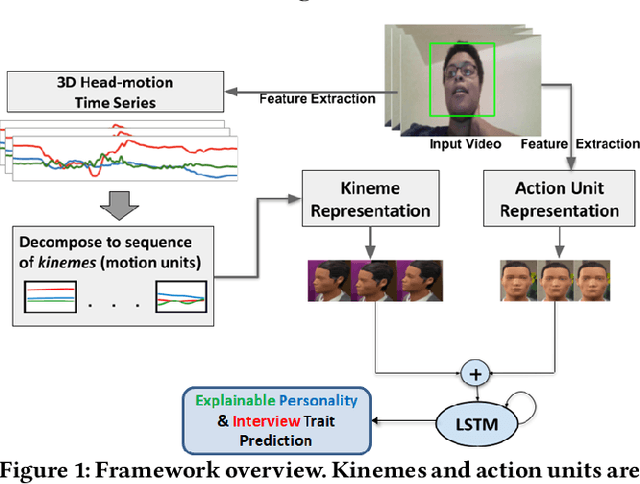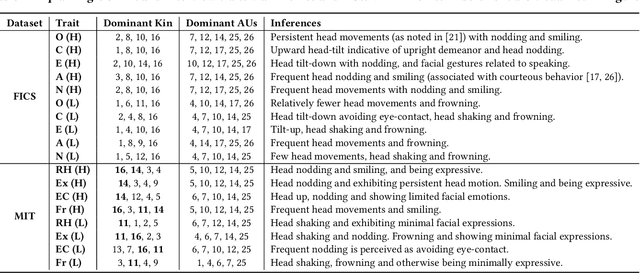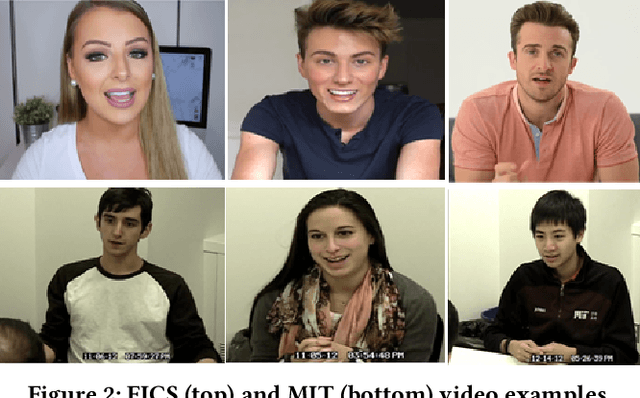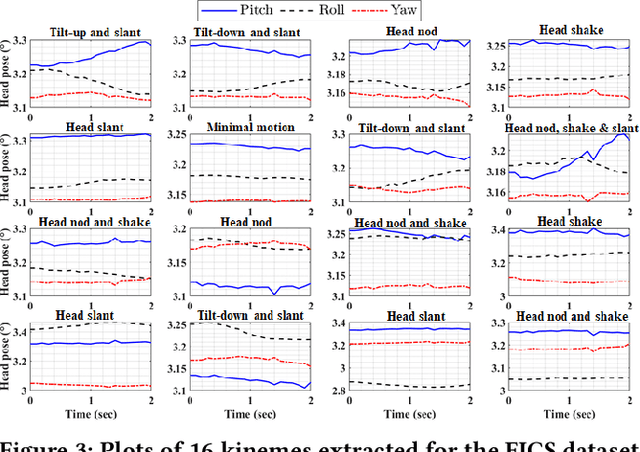Monika Gahalawat
On the Validity of Head Motion Patterns as Generalisable Depression Biomarkers
May 29, 2025Abstract:Depression is a debilitating mood disorder negatively impacting millions worldwide. While researchers have explored multiple verbal and non-verbal behavioural cues for automated depression assessment, head motion has received little attention thus far. Further, the common practice of validating machine learning models via a single dataset can limit model generalisability. This work examines the effectiveness and generalisability of models utilising elementary head motion units, termed kinemes, for depression severity estimation. Specifically, we consider three depression datasets from different western cultures (German: AVEC2013, Australian: Blackdog and American: Pitt datasets) with varied contextual and recording settings to investigate the generalisability of the derived kineme patterns via two methods: (i) k-fold cross-validation over individual/multiple datasets, and (ii) model reuse on other datasets. Evaluating classification and regression performance with classical machine learning methods, our results show that: (1) head motion patterns are efficient biomarkers for estimating depression severity, achieving highly competitive performance for both classification and regression tasks on a variety of datasets, including achieving the second best Mean Absolute Error (MAE) on the AVEC2013 dataset, and (2) kineme-based features are more generalisable than (a) raw head motion descriptors for binary severity classification, and (b) other visual behavioural cues for severity estimation (regression).
Explainable Depression Detection via Head Motion Patterns
Jul 23, 2023



Abstract:While depression has been studied via multimodal non-verbal behavioural cues, head motion behaviour has not received much attention as a biomarker. This study demonstrates the utility of fundamental head-motion units, termed \emph{kinemes}, for depression detection by adopting two distinct approaches, and employing distinctive features: (a) discovering kinemes from head motion data corresponding to both depressed patients and healthy controls, and (b) learning kineme patterns only from healthy controls, and computing statistics derived from reconstruction errors for both the patient and control classes. Employing machine learning methods, we evaluate depression classification performance on the \emph{BlackDog} and \emph{AVEC2013} datasets. Our findings indicate that: (1) head motion patterns are effective biomarkers for detecting depressive symptoms, and (2) explanatory kineme patterns consistent with prior findings can be observed for the two classes. Overall, we achieve peak F1 scores of 0.79 and 0.82, respectively, over BlackDog and AVEC2013 for binary classification over episodic \emph{thin-slices}, and a peak F1 of 0.72 over videos for AVEC2013.
Explainable Human-centered Traits from Head Motion and Facial Expression Dynamics
Feb 23, 2023



Abstract:We explore the efficacy of multimodal behavioral cues for explainable prediction of personality and interview-specific traits. We utilize elementary head-motion units named kinemes, atomic facial movements termed action units and speech features to estimate these human-centered traits. Empirical results confirm that kinemes and action units enable discovery of multiple trait-specific behaviors while also enabling explainability in support of the predictions. For fusing cues, we explore decision and feature-level fusion, and an additive attention-based fusion strategy which quantifies the relative importance of the three modalities for trait prediction. Examining various long-short term memory (LSTM) architectures for classification and regression on the MIT Interview and First Impressions Candidate Screening (FICS) datasets, we note that: (1) Multimodal approaches outperform unimodal counterparts; (2) Efficient trait predictions and plausible explanations are achieved with both unimodal and multimodal approaches, and (3) Following the thin-slice approach, effective trait prediction is achieved even from two-second behavioral snippets.
Head Matters: Explainable Human-centered Trait Prediction from Head Motion Dynamics
Dec 15, 2021



Abstract:We demonstrate the utility of elementary head-motion units termed kinemes for behavioral analytics to predict personality and interview traits. Transforming head-motion patterns into a sequence of kinemes facilitates discovery of latent temporal signatures characterizing the targeted traits, thereby enabling both efficient and explainable trait prediction. Utilizing Kinemes and Facial Action Coding System (FACS) features to predict (a) OCEAN personality traits on the First Impressions Candidate Screening videos, and (b) Interview traits on the MIT dataset, we note that: (1) A Long-Short Term Memory (LSTM) network trained with kineme sequences performs better than or similar to a Convolutional Neural Network (CNN) trained with facial images; (2) Accurate predictions and explanations are achieved on combining FACS action units (AUs) with kinemes, and (3) Prediction performance is affected by the time-length over which head and facial movements are observed.
 Add to Chrome
Add to Chrome Add to Firefox
Add to Firefox Add to Edge
Add to Edge